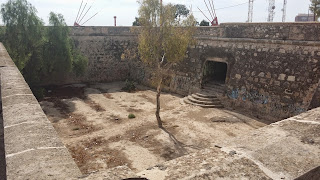
 The fall of Alicante in March 1939 marked the end of the Civil War as the last stronghold of the Republic surrendered to Italian fascist troops. Many of the thousands rounded up on the dockside were transported to the temporary concentration camp at Los Alemdros, those that survived the starvation and brutality were shipped to the permanent camp at San Isidro. I've covered those sites in earlier posts.
However, others after the fall, and specifically those sought out by the Falange and Franco's special forces were held in other parts of the City, notably the castles at San Fernando and Santa Barbara and the bull ring. These were torture and death centres.
San Fernando is just at the edge of the main city and reached via some impressive steps. The castle is a cold and oppressive place even on a warm September day and as you look down from the walls into the deserted keep it sent a shiver down my spine. This is where many anti-fascists were held, tortured and executed and the stillness, and the fact that even though it is on the edge of this bustling metropolis it was completely deserted, added to the heavy atmosphere. Unlike Santa Barbara this place is not sold as a tourist attraction. On a walk back into town I stopped off at the bull ring, the musuem says nothing of its role in the civil war and I couldn't get inside the main arena and you can only guess at the terror of those hauled off there when Alicante fell. No memorials, no recognition, no nothing.
The fall of Alicante in March 1939 marked the end of the Civil War as the last stronghold of the Republic surrendered to Italian fascist troops. Many of the thousands rounded up on the dockside were transported to the temporary concentration camp at Los Alemdros, those that survived the starvation and brutality were shipped to the permanent camp at San Isidro. I've covered those sites in earlier posts.
However, others after the fall, and specifically those sought out by the Falange and Franco's special forces were held in other parts of the City, notably the castles at San Fernando and Santa Barbara and the bull ring. These were torture and death centres.
San Fernando is just at the edge of the main city and reached via some impressive steps. The castle is a cold and oppressive place even on a warm September day and as you look down from the walls into the deserted keep it sent a shiver down my spine. This is where many anti-fascists were held, tortured and executed and the stillness, and the fact that even though it is on the edge of this bustling metropolis it was completely deserted, added to the heavy atmosphere. Unlike Santa Barbara this place is not sold as a tourist attraction. On a walk back into town I stopped off at the bull ring, the musuem says nothing of its role in the civil war and I couldn't get inside the main arena and you can only guess at the terror of those hauled off there when Alicante fell. No memorials, no recognition, no nothing.











